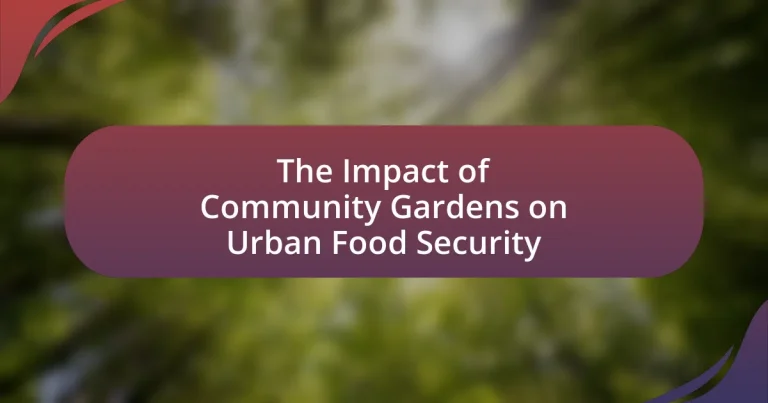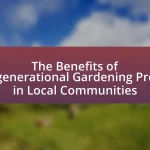Community gardens are shared plots of land where individuals or groups cultivate plants primarily for food production, playing a vital role in enhancing urban food security. They provide access to fresh produce in areas with limited grocery options, significantly increasing food availability and improving dietary habits among residents. The article explores how community gardens contribute to local food systems, the types of food that can be grown, their social and environmental benefits, and the challenges they face, including funding and zoning issues. Additionally, it discusses best practices for establishing and maintaining these gardens to maximize their impact on urban food security.

What are Community Gardens and Their Role in Urban Food Security?
Community gardens are shared plots of land where individuals or groups cultivate plants, primarily for food production. They play a crucial role in urban food security by providing access to fresh produce in areas where grocery stores may be scarce or expensive. According to a study published in the Journal of Agriculture, Food Systems, and Community Development, community gardens can increase food access by up to 30% in urban neighborhoods, thereby improving nutritional options for residents. Additionally, these gardens foster community engagement and education about sustainable practices, further enhancing food resilience in urban settings.
How do Community Gardens contribute to local food systems?
Community gardens contribute to local food systems by providing accessible spaces for urban residents to grow fresh produce, thereby enhancing food security. These gardens increase the availability of locally grown fruits and vegetables, which can reduce reliance on commercial food sources and lower food costs for participants. Research indicates that community gardens can produce up to 1,000 pounds of food per year on a quarter-acre plot, significantly impacting local food supply. Additionally, they foster community engagement and education about sustainable practices, which can lead to healthier eating habits and increased awareness of food systems.
What types of food can be grown in Community Gardens?
Community gardens can grow a variety of food types, including vegetables, fruits, herbs, and flowers. Common vegetables include tomatoes, peppers, lettuce, and carrots, while popular fruits often consist of strawberries, blueberries, and apples. Herbs such as basil, cilantro, and parsley are also frequently cultivated. Research indicates that community gardens enhance urban food security by providing fresh produce, which can improve access to nutritious food in urban areas where such options may be limited.
How do Community Gardens enhance access to fresh produce?
Community gardens enhance access to fresh produce by providing local residents with the opportunity to grow their own fruits and vegetables in shared spaces. These gardens increase food availability in urban areas, particularly in food deserts where access to fresh produce is limited. Research indicates that community gardens can significantly improve dietary habits by offering fresh, nutritious options, which is crucial for enhancing food security. For instance, a study published in the Journal of Agriculture, Food Systems, and Community Development found that participants in community gardening programs reported increased consumption of fruits and vegetables, demonstrating a direct link between gardening and improved access to fresh produce.
Why are Community Gardens important for urban communities?
Community gardens are important for urban communities because they enhance food security, promote social cohesion, and improve environmental sustainability. These gardens provide access to fresh produce, which is crucial in urban areas where food deserts often exist, leading to healthier diets and reduced food insecurity. Research indicates that community gardens can increase fruit and vegetable consumption by up to 50% among participants, thereby improving overall nutrition. Additionally, they foster community engagement by bringing together diverse groups of people, which strengthens social ties and encourages collaboration. Furthermore, community gardens contribute to urban biodiversity and help mitigate the urban heat island effect, making cities more resilient to climate change.
What social benefits do Community Gardens provide?
Community gardens provide significant social benefits, including enhanced community cohesion, improved mental health, and increased access to fresh produce. These gardens serve as communal spaces where individuals from diverse backgrounds can collaborate, fostering relationships and a sense of belonging. Research indicates that participation in community gardening can reduce feelings of isolation and promote social interaction, which is crucial for mental well-being. Additionally, community gardens often increase access to fresh fruits and vegetables, contributing to better nutrition and food security within urban areas. A study published in the Journal of Community Health found that neighborhoods with community gardens reported a 30% increase in fruit and vegetable consumption among residents, highlighting their role in promoting healthier lifestyles.
How do Community Gardens promote community engagement?
Community gardens promote community engagement by providing a shared space for individuals to collaborate on gardening activities, fostering social interactions and building relationships among diverse community members. These gardens serve as a platform for residents to participate in decision-making processes regarding garden management, which enhances a sense of ownership and responsibility. Research indicates that community gardens can increase social cohesion, as evidenced by a study published in the Journal of Community Psychology, which found that participants reported improved social ties and community involvement after engaging in gardening activities. This collaborative environment not only encourages teamwork but also facilitates the exchange of knowledge and cultural practices, further strengthening community bonds.
What challenges do Community Gardens face in urban settings?
Community gardens in urban settings face several challenges, including limited access to land, funding constraints, and regulatory hurdles. Limited access to land often results from high real estate prices and competing interests for urban space, making it difficult for community members to secure plots for gardening. Funding constraints hinder the ability to maintain gardens, purchase necessary supplies, and implement improvements, as many community gardens rely on grants or donations that may not be consistently available. Regulatory hurdles, such as zoning laws and restrictions on land use, can complicate the establishment and operation of community gardens, leading to conflicts with local authorities. These challenges collectively impact the sustainability and effectiveness of community gardens in enhancing urban food security.
How do zoning laws affect the establishment of Community Gardens?
Zoning laws significantly influence the establishment of community gardens by dictating land use regulations that determine where such gardens can be located. These laws can either facilitate or hinder the creation of community gardens based on the designated zoning classifications, such as residential, commercial, or agricultural. For instance, in areas zoned for residential use, community gardens may be permitted, while in industrial zones, they may be prohibited, limiting access to green spaces for urban agriculture. Additionally, specific zoning regulations may require permits or impose restrictions on the types of activities allowed in community gardens, impacting their operational viability. Studies have shown that cities with supportive zoning policies tend to have a higher number of community gardens, which contribute to urban food security by providing local food sources and fostering community engagement.
What are the common funding issues for Community Gardens?
Common funding issues for community gardens include limited access to grants, inconsistent funding sources, and competition for financial resources. Many community gardens rely on grants from local governments or non-profit organizations, but these grants can be highly competitive and often have strict eligibility requirements. Additionally, funding may be inconsistent, leading to challenges in maintaining garden operations and infrastructure. According to a study published in the Journal of Agriculture, Food Systems, and Community Development, 60% of community gardens reported difficulties in securing sustainable funding, highlighting the need for more reliable financial support to ensure their longevity and impact on urban food security.

How do Community Gardens Impact Food Security in Urban Areas?
Community gardens significantly enhance food security in urban areas by providing accessible sources of fresh produce to local residents. These gardens enable individuals, particularly those in low-income neighborhoods, to grow their own fruits and vegetables, thereby reducing reliance on expensive grocery stores. Research indicates that community gardens can increase access to nutritious food, with studies showing that participants often consume more fruits and vegetables compared to non-participants. Additionally, community gardens foster social cohesion and empower residents, which can lead to improved community resilience and food sovereignty. For instance, a study published in the Journal of Agriculture, Food Systems, and Community Development found that community gardens contribute to food security by increasing food availability and promoting self-sufficiency among urban populations.
What is the relationship between Community Gardens and food insecurity?
Community gardens directly address food insecurity by providing access to fresh produce in urban areas where such resources may be limited. These gardens enable individuals and families to grow their own fruits and vegetables, thereby reducing reliance on expensive grocery stores and improving dietary options. Research indicates that community gardens can increase food access, with studies showing that participants often report improved food security and dietary diversity. For instance, a study published in the Journal of Agriculture, Food Systems, and Community Development found that community gardens significantly enhance food availability and contribute to healthier eating habits among participants.
How do Community Gardens help alleviate food deserts?
Community gardens help alleviate food deserts by providing local access to fresh produce, which is often scarce in these areas. These gardens enable communities to grow fruits and vegetables, directly addressing the lack of nutritious food options. Research indicates that community gardens can increase fruit and vegetable consumption among participants by up to 50%, thereby improving overall dietary health. Additionally, community gardens foster social cohesion and empower residents, leading to increased advocacy for better food access policies. Studies show that neighborhoods with community gardens experience a reduction in food insecurity rates, highlighting their role in enhancing urban food security.
What role do Community Gardens play in improving nutritional access?
Community gardens significantly enhance nutritional access by providing fresh produce to urban populations, particularly in food deserts. These gardens enable individuals and families to grow their own fruits and vegetables, which increases the availability of nutritious food options. Research indicates that community gardens can improve dietary habits by increasing the consumption of fresh produce, as evidenced by a study published in the Journal of Community Health, which found that participants in community gardening programs reported a 40% increase in fruit and vegetable intake. Additionally, community gardens foster a sense of community and education around nutrition, further promoting healthy eating practices among participants.
How do Community Gardens influence local economies?
Community gardens positively influence local economies by increasing access to fresh produce, creating jobs, and fostering local entrepreneurship. These gardens provide a source of affordable fruits and vegetables, which can reduce food costs for residents and improve overall community health. According to a study published in the Journal of Agriculture, Food Systems, and Community Development, community gardens can generate an estimated $2,000 to $5,000 in produce per year, contributing to local food systems and reducing reliance on external food sources. Additionally, they often create employment opportunities through garden management, workshops, and local markets, stimulating economic activity within the community. Furthermore, community gardens can encourage local entrepreneurship by providing a platform for small businesses, such as farmers’ markets and food-related ventures, thereby enhancing the local economy.
What economic benefits do Community Gardens bring to neighborhoods?
Community gardens provide significant economic benefits to neighborhoods by increasing local food production, enhancing property values, and fostering community engagement. These gardens reduce food costs for residents by providing access to fresh produce, which can lead to savings of approximately $500 per household annually, as reported by the American Community Gardening Association. Additionally, community gardens can increase surrounding property values by up to 9% due to improved aesthetics and neighborhood cohesion. Furthermore, they create job opportunities and stimulate local economies through the sale of produce and related goods, contributing to a more sustainable economic environment.
How can Community Gardens create job opportunities?
Community gardens can create job opportunities by providing employment in various roles such as garden management, maintenance, and educational programming. These gardens often require staff to oversee operations, coordinate volunteers, and manage resources, which can lead to job creation in local communities. For instance, a study by the American Community Gardening Association found that community gardens can generate jobs related to horticulture, landscaping, and community outreach, contributing to local economies. Additionally, community gardens can foster entrepreneurship by enabling individuals to sell produce or products derived from the garden, further enhancing job prospects within the community.
What are the environmental impacts of Community Gardens?
Community gardens positively impact the environment by enhancing biodiversity, improving air quality, and promoting sustainable land use. These gardens provide habitats for various species, including pollinators like bees and butterflies, which are crucial for ecosystem health. Research indicates that urban green spaces, such as community gardens, can increase local biodiversity by up to 30% compared to areas without green spaces. Additionally, community gardens contribute to improved air quality by absorbing carbon dioxide and releasing oxygen, which helps mitigate urban pollution. They also promote sustainable land use by transforming vacant lots into productive green spaces, reducing urban heat islands, and managing stormwater runoff effectively.
How do Community Gardens contribute to urban biodiversity?
Community gardens contribute to urban biodiversity by providing habitats for various plant and animal species, enhancing ecological resilience in urban areas. These gardens often include a diverse range of plants, which attract pollinators such as bees and butterflies, and support other wildlife, thereby increasing species richness. Research indicates that urban green spaces, including community gardens, can host up to 30% more species than surrounding urban environments, promoting a healthier ecosystem. Additionally, community gardens can improve soil health and water retention, further supporting biodiversity by creating a more sustainable urban landscape.
What role do Community Gardens play in sustainable urban development?
Community gardens play a crucial role in sustainable urban development by enhancing local food production, fostering community engagement, and promoting biodiversity. These gardens provide accessible spaces for residents to grow their own food, which contributes to food security and reduces reliance on industrial agriculture. Research indicates that urban agriculture, including community gardens, can increase local food availability by up to 30%, thereby improving nutrition and health outcomes for urban populations. Additionally, community gardens serve as green spaces that support biodiversity by providing habitats for various species, which is essential for ecological balance in urban environments. Furthermore, they encourage social cohesion by bringing together diverse community members, fostering relationships, and promoting environmental stewardship.

What Best Practices Can Enhance the Impact of Community Gardens on Urban Food Security?
Best practices that can enhance the impact of community gardens on urban food security include establishing strong community engagement, implementing educational programs, and ensuring sustainable practices. Strong community engagement fosters ownership and participation, which has been shown to increase garden productivity and food distribution. Educational programs, such as workshops on gardening techniques and nutrition, empower community members with knowledge, leading to improved food choices and gardening success. Sustainable practices, including organic gardening and water conservation, not only protect the environment but also ensure long-term viability of the gardens, contributing to consistent food availability. Research indicates that community gardens can increase access to fresh produce by up to 40%, significantly improving urban food security.
How can communities effectively establish and maintain Community Gardens?
Communities can effectively establish and maintain community gardens by forming a dedicated group of volunteers to oversee the project, securing land access, and creating a clear plan for garden management. A dedicated group ensures consistent leadership and organization, which is crucial for long-term success. Securing land can involve negotiating with local governments or private landowners, as evidenced by the success of community gardens in cities like New York, where over 600 community gardens thrive on previously vacant lots. A clear management plan should include guidelines for planting, maintenance, and community involvement, which can enhance participation and sustainability. Research shows that community gardens can increase access to fresh produce, thereby improving urban food security, as highlighted in the study “Community Gardens and Urban Agriculture: A Review of the Literature” by the American Journal of Community Psychology.
What strategies can be employed to engage community members?
To engage community members effectively, strategies such as organizing workshops, creating volunteer opportunities, and fostering partnerships with local organizations can be employed. Workshops provide education on gardening techniques and nutrition, which can enhance community knowledge and involvement. Volunteer opportunities allow residents to contribute actively, fostering a sense of ownership and connection to the community garden. Additionally, partnerships with local organizations can amplify resources and outreach, ensuring diverse community representation and support. Research indicates that community gardens significantly improve social cohesion and food security, as evidenced by a study published in the Journal of Community Health, which found that community gardens increase access to fresh produce and strengthen community ties.
How can partnerships with local organizations strengthen Community Gardens?
Partnerships with local organizations can strengthen Community Gardens by providing essential resources, expertise, and community engagement. Local organizations often contribute funding, volunteer support, and educational programs that enhance the operational capacity of Community Gardens. For instance, a study by the American Community Gardening Association found that gardens partnered with local nonprofits experienced a 30% increase in volunteer participation, leading to improved maintenance and productivity. Additionally, these partnerships can facilitate access to local markets, allowing gardeners to sell their produce, thereby increasing food security within urban areas.
What resources are available for Community Garden initiatives?
Community Garden initiatives have access to various resources including funding, educational materials, and community support networks. Funding can come from local government grants, nonprofit organizations, and crowdfunding platforms, which help cover costs for seeds, tools, and infrastructure. Educational materials are often provided by agricultural extension services and local universities, offering workshops and guides on sustainable gardening practices. Additionally, community support networks, such as gardening clubs and local food organizations, facilitate collaboration and resource sharing among gardeners, enhancing the overall success and sustainability of community gardens.
How can communities access funding for Community Gardens?
Communities can access funding for Community Gardens through various sources such as grants, local government programs, and nonprofit organizations. For instance, the USDA Community Food Projects Competitive Grant Program provides funding specifically for projects that address food insecurity and promote community gardening. Additionally, local municipalities often have budget allocations for urban agriculture initiatives, which can be accessed through proposals or applications. Nonprofit organizations like the American Community Gardening Association also offer resources and funding opportunities tailored to community gardens. These funding avenues are crucial for supporting the establishment and maintenance of community gardens, which play a significant role in enhancing urban food security.
What educational programs support the development of Community Gardens?
Educational programs that support the development of community gardens include Master Gardener programs, community-based workshops, and school gardening initiatives. Master Gardener programs, often run by universities, provide training in horticulture and sustainable gardening practices, equipping participants with the skills needed to establish and maintain community gardens. Community-based workshops, organized by local non-profits or gardening clubs, offer hands-on learning experiences that cover topics such as soil health, plant selection, and pest management. School gardening initiatives integrate gardening into the curriculum, teaching students about food systems, nutrition, and environmental stewardship while fostering a sense of community. These educational programs collectively enhance knowledge and skills, promoting the successful establishment and sustainability of community gardens, which in turn contribute to urban food security.
What are the key takeaways for maximizing the benefits of Community Gardens?
To maximize the benefits of community gardens, it is essential to foster community involvement, ensure diverse plant selection, and provide educational resources. Community involvement enhances social cohesion and encourages shared responsibility, which has been shown to increase participation rates and garden sustainability. Diverse plant selection caters to various dietary needs and preferences, promoting food security by providing a wider range of produce. Educational resources, such as workshops on gardening techniques and nutrition, empower community members with knowledge, leading to better gardening practices and healthier eating habits. These strategies collectively enhance the effectiveness of community gardens in addressing urban food security challenges.





